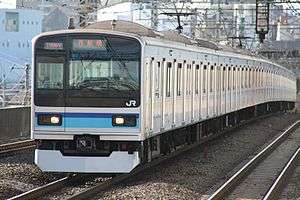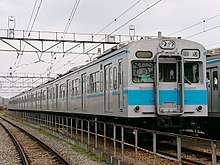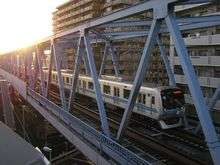Tokyo Metro Tōzai Line
| Tokyo Metro Tozai Line | |
|---|---|
|
| |
 | |
| Overview | |
| Native name | 東京メトロ東西線 |
| Locale | Tokyo, Chiba prefectures |
| Termini |
Nakano Nishi-Funabashi |
| Stations | 23 |
| Daily ridership | 1,642,378 (2017)[1] |
| Operation | |
| Opened | December 23, 1964 |
| Owner | Tokyo Metro |
| Depot(s) | Fukagawa, Gyōtoku |
| Rolling stock |
Tokyo Metro 05/05N series Tokyo Metro 07 series Tokyo Metro 15000 series Tōyō Rapid 2000 series JR East E231-800 series |
| Technical | |
| Line length | 30.8 km (19.1 mi) |
| Track gauge | 1,067 mm (3 ft 6 in) |
| Electrification | 1,500 V DC overhead catenary |
| Operating speed | 100 km/h (62 mph) |
| Route map | ||||||||||||||||||||||||||||||||||||||||||||||||||||||||||||||||||||||||||||||||||||||||||||||||||||||||||||||||||||||||||||||||||||||||||||||||||||||||||||||||||||||||||||||||||||||||||||||||||||||||||||||||||||||||||||||||||||||||||||||||||||||||||||||||||||||||||||||||||||||||||||||||||||||||||||||||||||||||||||||||||||||||||||||||||||||||||||||||||||||||||||||||||||||||||||||||||||||||||||||||||||||||||||||||||||||||||||||||||||||||||||||||||||||||||||||||||||||||||||||||||||||||||||||||||||||||||||||||||||||||||||||||||||||||||||||||||||||||||||||||||||||||||||||||||||||||||||||||||||||||||||||||||||||||||||||||||||||||||||||||||||||||||||||||||||||||||||||||||||||||||||||||||||||||||||||||||||||||||||||||||||||||||||||||
|---|---|---|---|---|---|---|---|---|---|---|---|---|---|---|---|---|---|---|---|---|---|---|---|---|---|---|---|---|---|---|---|---|---|---|---|---|---|---|---|---|---|---|---|---|---|---|---|---|---|---|---|---|---|---|---|---|---|---|---|---|---|---|---|---|---|---|---|---|---|---|---|---|---|---|---|---|---|---|---|---|---|---|---|---|---|---|---|---|---|---|---|---|---|---|---|---|---|---|---|---|---|---|---|---|---|---|---|---|---|---|---|---|---|---|---|---|---|---|---|---|---|---|---|---|---|---|---|---|---|---|---|---|---|---|---|---|---|---|---|---|---|---|---|---|---|---|---|---|---|---|---|---|---|---|---|---|---|---|---|---|---|---|---|---|---|---|---|---|---|---|---|---|---|---|---|---|---|---|---|---|---|---|---|---|---|---|---|---|---|---|---|---|---|---|---|---|---|---|---|---|---|---|---|---|---|---|---|---|---|---|---|---|---|---|---|---|---|---|---|---|---|---|---|---|---|---|---|---|---|---|---|---|---|---|---|---|---|---|---|---|---|---|---|---|---|---|---|---|---|---|---|---|---|---|---|---|---|---|---|---|---|---|---|---|---|---|---|---|---|---|---|---|---|---|---|---|---|---|---|---|---|---|---|---|---|---|---|---|---|---|---|---|---|---|---|---|---|---|---|---|---|---|---|---|---|---|---|---|---|---|---|---|---|---|---|---|---|---|---|---|---|---|---|---|---|---|---|---|---|---|---|---|---|---|---|---|---|---|---|---|---|---|---|---|---|---|---|---|---|---|---|---|---|---|---|---|---|---|---|---|---|---|---|---|---|---|---|---|---|---|---|---|---|---|---|---|---|---|---|---|---|---|---|---|---|---|---|---|---|---|---|---|---|---|---|---|---|---|---|---|---|---|---|---|---|---|---|---|---|---|---|---|---|---|---|---|---|---|---|---|---|---|---|---|---|---|---|---|---|---|---|---|---|---|---|---|---|---|---|---|---|---|---|---|---|---|---|---|---|---|---|---|---|---|---|---|---|---|---|---|---|---|---|---|---|---|---|---|---|---|---|---|---|---|---|---|---|---|---|---|---|---|---|---|---|---|---|---|---|---|---|---|---|---|---|---|---|---|---|---|---|---|---|---|---|---|---|---|---|---|---|---|---|---|---|---|---|---|---|---|---|---|---|---|---|---|---|---|---|---|---|---|---|---|---|---|---|---|---|---|---|---|---|---|---|---|---|---|---|---|---|---|---|---|---|---|---|---|---|---|---|---|---|---|---|---|---|---|---|---|---|---|---|---|---|---|---|---|---|---|---|---|---|---|---|---|---|---|---|---|---|---|---|---|---|---|---|---|---|---|---|---|---|---|---|---|---|---|---|---|---|---|---|---|---|---|---|---|---|---|---|---|---|---|---|---|---|---|---|---|---|---|---|---|---|---|---|---|---|---|---|---|---|---|---|---|---|---|---|---|---|---|---|---|---|---|---|---|---|---|---|---|---|---|---|---|---|---|---|---|---|---|---|---|---|---|---|---|---|---|---|---|---|---|---|---|---|---|---|---|---|---|---|---|---|---|---|---|---|---|---|---|---|---|---|---|---|---|---|---|---|---|---|---|---|---|---|---|---|---|---|---|---|---|---|---|---|---|---|---|---|---|---|---|---|---|
| ||||||||||||||||||||||||||||||||||||||||||||||||||||||||||||||||||||||||||||||||||||||||||||||||||||||||||||||||||||||||||||||||||||||||||||||||||||||||||||||||||||||||||||||||||||||||||||||||||||||||||||||||||||||||||||||||||||||||||||||||||||||||||||||||||||||||||||||||||||||||||||||||||||||||||||||||||||||||||||||||||||||||||||||||||||||||||||||||||||||||||||||||||||||||||||||||||||||||||||||||||||||||||||||||||||||||||||||||||||||||||||||||||||||||||||||||||||||||||||||||||||||||||||||||||||||||||||||||||||||||||||||||||||||||||||||||||||||||||||||||||||||||||||||||||||||||||||||||||||||||||||||||||||||||||||||||||||||||||||||||||||||||||||||||||||||||||||||||||||||||||||||||||||||||||||||||||||||||||||||||||||||||||||||||
The Tokyo Metro Tozai Line (東京メトロ東西線 Tōkyō Metoro Tōzai-sen) is a rapid transit line in Tokyo and Chiba Prefecture, Japan, owned and operated by Tokyo Metro. Its name literally means East-West Line. The line runs between Nakano Station in Nakano, Tokyo and Nishi-Funabashi Station in Funabashi, Chiba. The Tōzai Line was referred to as Line 5 during the planning stages, thus the seldom-used official name is Line 5 Tōzai Line (5号線東西線 Go-gō-sen Tōzai-sen). On average, the line carries 1,642,378 passengers daily (2017), the highest of all lines in the Tokyo Metro network[2].
Overview
The Tōzai Line features through services on both ends. Trains run through onto the East Japan Railway Company (JR East)'s Chūō-Sōbu Line for Mitaka at the western end and onto the Tōyō Rapid Railway Line for Tōyō-Katsutadai at the eastern end, making the line an alternative route to the Chūō-Sōbu between Nakano and Nishi-Funabashi.
According to the Tokyo Metropolitan Bureau of Transportation, as of June 2009 the Tokyo Metro Tōzai Line was the most crowded subway line in Tokyo, at its peak running at 199% capacity between Kiba and Monzen-Nakachō stations.[3] Women-only cars were introduced on the line during morning rush hours starting on November 20, 2006.
On maps, diagrams and signboards, the Tōzai Line is shown using the color "sky blue" (T), and its stations are given numbers using the letter "T".
Services
The Tōzai Line was the first Tokyo Metro line on which express services run: two types of rapid trains skip some stations east of Toyocho. The Tokyo Metro Fukutoshin Line began services on June 14, 2008 and also features express services.
Through services to Mitaka via the JR East Chūō Line (Local) and Tōyō-Katsutadai via the Tōyō Rapid Railway run all day. During the morning and evening peak periods, through services run to Tsudanuma via the JR East Sōbu Line (Local).
Station list
- Local trains stop at every station. Rapid trains stop at stations marked "●" and do not stop at those marked "|". Some weekday westbound trains do not stop at stations marked "↑".
| No. | Station | Japanese | Distance (km) | Comm. Rapid | Rapid | Transfers | Location | ||
|---|---|---|---|---|---|---|---|---|---|
| Between stations |
From Nakano | ||||||||
| ↑ Through-services to/from Mitaka via the JB Chūō-Sōbu Line ↑ | |||||||||
| T01 | Nakano | 中野[* 1] | - | 0.0 | ● | ● | Nakano | Tokyo | |
| T02 | Ochiai | 落合 | 2.0 | 2.0 | ● | ● | Shinjuku | ||
| T03 | Takadanobaba | 高田馬場 | 1.9 | 3.9 | ● | ● | |||
| T04 | Waseda | 早稲田 | 1.7 | 5.6 | ● | ● | Tokyo Sakura Tram (Waseda)[* 2] | ||
| T05 | Kagurazaka | 神楽坂 | 1.2 | 6.8 | ● | ● | |||
| T06 | Iidabashi | 飯田橋 | 1.2 | 8.0 | ● | ● |
|
Chiyoda | |
| T07 | Kudanshita | 九段下 | 0.7 | 8.7 | ● | ● |
| ||
| T08 | Takebashi | 竹橋 | 1.0 | 9.7 | ● | ● | |||
| T09 | Ōtemachi | 大手町 | 1.0 | 10.7 | ● | ● |
| ||
| T10 | Nihombashi | 日本橋 | 0.8 | 11.5 | ● | ● |
|
Chūō | |
| T11 | Kayabachō | 茅場町 | 0.5 | 12.0 | ● | ● | H Tokyo Metro Hibiya Line (H-12) | ||
| T12 | Monzen-Nakachō | 門前仲町 | 1.8 | 13.8 | ● | ● | E Toei Oedo Line (E-15) | Kōtō | |
| T13 | Kiba | 木場 | 1.1 | 14.9 | ● | ● | |||
| T14 | Tōyōchō | 東陽町 | 0.9 | 15.8 | ● | ● | |||
| T15 | Minami-Sunamachi | 南砂町 | 1.2 | 17.0 | ● | | | |||
| T16 | Nishi-Kasai | 西葛西 | 2.7 | 19.7 | ● | | | Edogawa | ||
| T17 | Kasai | 葛西 | 1.2 | 20.9 | ● | | | |||
| T18 | Urayasu | 浦安 | 1.9 | 22.8 | ● | ● | Urayasu | Chiba | |
| T19 | Minami-Gyōtoku | 南行徳 | 1.2 | 24.0 | ↑ | | | Ichikawa | ||
| T20 | Gyōtoku | 行徳 | 1.5 | 25.5 | ↑ | | | |||
| T21 | Myōden | 妙典 | 1.3 | 26.8 | ↑ | | | |||
| T22 | Baraki-Nakayama | 原木中山 | 2.1 | 28.9 | ↑ | | | Funabashi | ||
| T23 | Nishi-Funabashi | 西船橋[* 3] | 1.9 | 30.8 | ● | ● | |||
| ↓ Through-services to/from Tōyō-Katsutadai via the TR Tōyō Rapid Railway Line ↓ or
↓ Through-services to/from Tsudanuma via the JB Chūō-Sōbu Line ↓ | |||||||||
- ↑ Nakano is shared by Tokyo Metro and JR East; JR East manages the station.
- ↑ Both the Tokyo Metro and Toei stations are displayed on station maps as being distant from one another, and they are not announced as transfer points for one another.
- ↑ Nishi-Funabashi is shared by Tokyo Metro, Tōyō Rapid Railway, and JR East; JR East manages the station.
Rolling stock
Present
Tōzai Line trains are 10-car formations of 20-meter-long cars, with four doors per side and longitudinal seating. The maximum operating speed is 100 km/h.
- Tokyo Metro
- 05/05N series (since 1988)
- 07 series (since 2006) (transferred from Yūrakuchō Line)
- 15000 series (since 2010)
- Tōyō Rapid Railway
- 2000 series (since 2004)
- East Japan Railway Company (JR East)
- E231-800 series (since 2003)
- From left, 07 series, 05N series, 05 series, stainless steel 5000 series, aluminium 5000 series
 Toyo Rapid 2000 series
Toyo Rapid 2000 series JR East E231-800 series in December 2009
JR East E231-800 series in December 2009
Past
- Tokyo Metro
- 5000 series (from 1964 until 2007)
- 8000 series (from 1987 until 1988, temporary, built for Hanzōmon Line)
- JR East
- 301 series (from 1966 until 2003)
- 103-1000 series (from 1989 until 2003)
- 103-1200 series (from 1971 until 2003)
- Tōyō Rapid
- 1000 series (from 1996 until 2006)
- 5000 series with stainless steel body
- 5000 series with aluminium body
- JR East 301 series in February 2003
 JR East 103-1200 series
JR East 103-1200 series- Tōyō Rapid 1000 series in September 2006
Depots

- Fukagawa Depot (深川検車区)
- Gyōtoku Depot (深川検車区行徳分室)
- Fukagawa Workshop (深川工場)
History

The Tōzai Line was planned by a review committee of the then Ministry of Transportation in 1962 and numbered Line 5. Its name literally means "East-West Line", and it was primarily planned to relieve traffic on the busy Sōbu Main Line as well as provide a straight crosstown connection through north-central Tokyo. Although this corridor is now served by the Tokyo Metropolitan Bureau of Transportation (Toei) Shinjuku Line and JR Keiyō Line as well, the Tōzai Line continues to operate beyond capacity due to its accessibility to other lines, as well as to growing condominium developments in eastern Tokyo.
The Takadanobaba to Kudanshita section opened in 1964, and the remainder opened in stages until its completion in 1969. Through service with the then Japanese National Railways (today part of the JR Group) - a first for a Tokyo subway line - began in 1969 connecting the Chūō and Sōbu lines. This is a rare situation in Tokyo, as the only other subway line with through services onto JR lines is the Chiyoda Line.
The Tōyō Rapid Railway Line, effectively an eastward extension of the line, opened in 1996. It nevertheless remains a private entity to which the Tōzai lines offers through services with.
Chronology
- March 16, 1966: The line is extended at both ends. It now runs between Nakano and Takebashi.
- April 28, 1966: Through service to the Chūō Line of JNR commences as far as Ogikubo.
- October 1, 1966: Takebashi to Ōtemachi section opens.
- September 14, 1967: Ōtemachi to Tōyōchō section opens.
- March 29, 1969: Tōyōchō to Nishi-Funabashi section opens and Rapid service begins (non-stop between Tōyōchō and Nishi-Funabashi).
- April 8, 1969: Through service on the Chūō Line is extended to Mitaka, and through service begins on the Sōbu line to Tsudanuma.
- April 8, 1972: Through service on the Sōbu Line is withdrawn except during rush hours.
- 1975: Another type of Rapid service is introduced, calling at Urayasu between Tōyōchō and Nishi-Funabashi.
- October 1, 1979: Nishi-Kasai station opens.
- March 27, 1981: Minami-Gyōtoku station opens.
- 1986: Commuter Rapid service is introduced, running non-stop between Urayasu and Nishi-Funabashi.
- (April 1, 1987: JNR is privatised. The Chūō and Sōbu lines become the property of JR East.)
- (March 20, 1995: The Tokyo subway Sarin gas attack occurred on the Chiyoda, Marunouchi, and Hibiya lines.)
- 1996: The Rapid service that runs non-stop between Tōyōchō and Nishi-Funabashi ceases.
- April 27, 1996: Tōyō Rapid Line opens between Nishi-Funabashi and Tōyō-Katsutadai. Through service begins.
- January 22, 2000: Myōden station opens.
- April 1, 2004: Teito Rapid Transit Authority (TRTA or Eidan) becomes Tokyo Metro.
- November 20, 2006: Women-only cars are introduced during morning rush hours.
References
- Shaw, Dennis and Morioka, Hisashi, "Tokyo Subways", published 1992 by Hoikusha Publishing
- ↑ Tokyo Metro station ridership in 2017 Train Media (sourced from Tokyo Metro) Retrieved July 23, 2018.
- ↑ Tokyo Metro station ridership in 2017 Train Media (sourced from Tokyo Metro) Retrieved July 23, 2018.
- ↑ Metropolis, "Commute", June 12, 2009, p. 07. Capacity is defined as all passengers having a seat or a strap or door railing to hold on to.
External links
| Wikimedia Commons has media related to Tokyo Metro Tōzai Line. |
- Tokyo Metro website (in English)